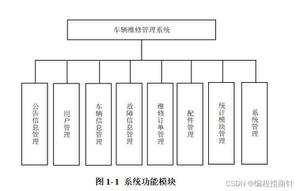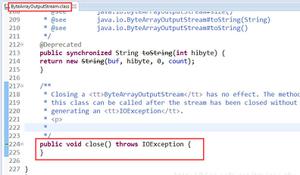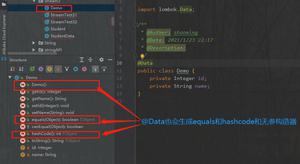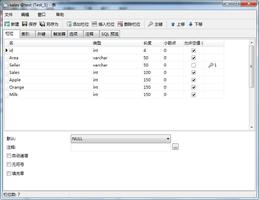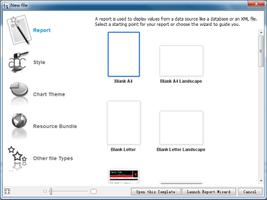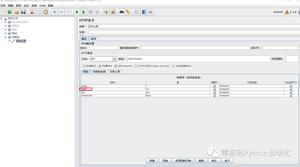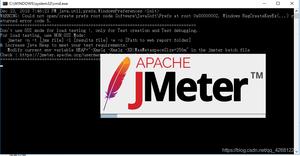使用JasperReport与iBATIS开发Web报表
JasperReport是一种采用纯Java实现的快速且非常流行的生成报表的类库。而对于任何的报表方案,取得数据并传递给报表引擎是其中最重要且最值得关心的方面。但遗憾的是,在这方面JasperReport本身似乎有一定的不足。而如今的很多Java应用程序,采用数据获取框架来进行数据的匹配与动态生成SQL。例如iBATIS数据映射框架。当然,如果只是使用JasperReport获取数据及管理数据的默认机制的话,不足以与现成的数据框架进行很好的平衡。但可喜的是,可以通过使用传递给JasperReport一个数据库的连接进行代替,当然这种连接可以通过使用XML进行非常方便的管理与配置。
一、 准备工作
与Hibernate类似,iBATIS也是一个ORM解决方案,不同的是两者各有侧重。Hibernate提供了Java对象到数据库表之间的直接映射,开发者无需直接涉及数据库操作的实现细节,实现了一站式的ORM解决方案。而iBATIS则采取了另一种方式,即提供Java对象到SQL(面向参数和结果集)的映射实现,实际的数据库操作需要通过手动编写SQL实现。
iBATIS是又一个O/R Mapping解决方案,j2ee的O/R方案真是多,和Hibernate相比,iBATIS最大的特点就是小巧,上手很快。如果你不需要太多复杂的功能,iBATIS是能满足你的要求又足够灵活的最简单的解决方案。在本文的示例中,采用Spring+JSF+iBATIS的模式进行示例的开发。所使用的lib如下图所示:
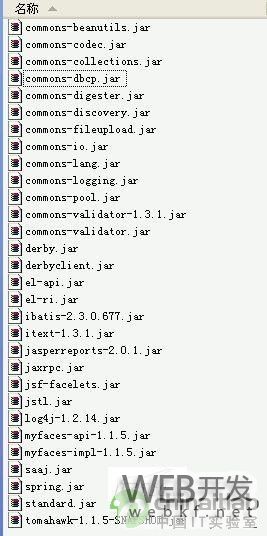
二、 在iReport中可视化定制模板
定制报表格式有二种方式,一种就是写jrxml文件,其实就是xml文件,只不过是后缀名不一样罢了。另一种方式更直接,就是生成一个JasperDesign类的实例,在japsperDesign中自己定义模板。jrxml文件也是通过一个JRXmlLoad加载过来,转成JasperDesign类的实例。也就是说写jrxml文件还需要进行解析,加载。现实中我们使用的报表一般格式比较固定,因而可以通过先使用iReport工具生成模板,再加载解析的方式。这种方式简单,而且可见性强。
iReport做为一个优秀的报表设计器,有着功能非常强大的特性。作为开源的Java程序,不但有适合于Windows安装的应用程序,同时,还提供完全开放的源代码,可供参考及原理分析。在本文中,主要通过图形界面中的模板设计,以及与数据库的连接等一系列的操作,来介绍如何定制一定要求的报表模板。 通过iReport可初见化的图形界面,可以设计出各种各样的简单或复杂的报表。通过iReport的这种可视化界面设计,可以为JasperReport提供优秀的报表模板,而无须去理解或是掌握那些复杂的XML语法。如此则可以Web报表开发节省大量的开发时间。 在进行iReport模板设计之前,需要编写JavaBean类:MonthlySalesBean.java,代码如下:
import java.math.BigDecimal;
import java.util.ArrayList;
import java.util.List;
publicclass MonthlySalesBean {
privateint employeeID;;
private String last =null;
private String first =null;
private BigDecimal total =null;
private List sales =null;
private LatestSale latestSale =null;
publicstatic List createBeanCollection () {
List list =new ArrayList ();
MonthlySalesBean msb =new MonthlySalesBean ();
msb.setEmployeeID(1);
msb.setFirst("John");
msb.setLast("Doe");
msb.setTotal(new BigDecimal ("1600.50"));
LatestSale ls =new LatestSale ();
ls.setAmount(new BigDecimal ("32.21"));
msb.setLatestSale(ls);
list.add(msb);
return list;
}
publicint getEmployeeID() {
return employeeID;
}
publicvoid setEmployeeID(int employeeID) {
this.employeeID = employeeID;
}
public String getFirst() {
return first;
}
publicvoid setFirst(String first) {
this.first = first;
}
public String getLast() {
return last;
}
publicvoid setLast(String last) {
this.last = last;
}
public BigDecimal getTotal() {
return total;
}
publicvoid setTotal(BigDecimal total) {
this.total = total;
}
public List getSales() {
return sales;
}
publicvoid setSales(List sales) {
this.sales = sales;
}
public LatestSale getLatestSale() {
return latestSale;
}
publicvoid setLatestSale(LatestSale latestSale) {
this.latestSale = latestSale;
}
}
将上面的类打成一个jar包,并置于classpath目录下,则iReport可以进行访问。使用JavaBean做为数据源,为了在设计报表时能够看到数据,在程序中要为iReport提供一个静态方法,该方法返回上面定义JavaBean的一个结果集,这个静态方法可能在程序运行中并不是必须的,但是在iReport中它确实必须的,换句话说,这个静态方法是专门为iReport量身定做的,为了iReport在设计报表时能够调用这个静态方法返回相应的JavaBean结果集,以便设计的报表放在Java项目中之前就能像使用SQL数据库数据源一样可以浏览。在iReport中先进行数据源的连接配置,此处采用是JavaBeans set data source连接方式:
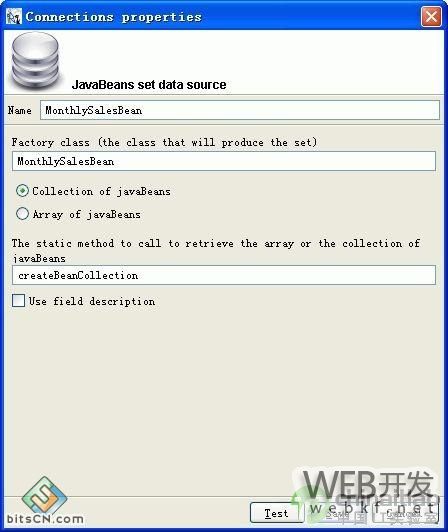
三、 处理iBati返回数据
如果iBATIS没有采用JavaBean作为返回对象,则可以采用java.util.map作为数据的返回对象。采用java.util.Map对象,需要额外的一些步骤。下面的代码则说明了iBATIS的select语句返回的java.util.Map对象。Src/ iBATIS.xml:
<?xml version="1.0" encoding="UTF-8"?>
<!DOCTYPE sqlMap PUBLIC "-//iBATIS.com//DTD SQL Map 1.0//EN"
"http://iBATIS.apache.org/dtd/sql-map-2.dtd">
<sqlMap>
<select id="salesByListOfMapsSQL" resultClass="java.util.HashMap">
SELECT
E.EMPLOYEE_ID "ID",
E.FIRST_NAME "FIRST",
E.LAST_NAME "LAST",
MS.TOTAL_SALES "TOTAL",
MS.LATEST_SALE
FROM
EMPLOYEE E,
MONTHLY_SALES MS
WHERE
E.EMPLOYEE_ID = MS.EMPLOYEE_ID
AND MS.MONTH = #value#
</select>
<resultMap id="searchResultList" class="MonthlySalesBean">
<result property="employeeID" column="ID"/>
<result property="first" column="FIRST"/>
<result property="last" column="LAST"/>
<result property="total" column="TOTAL"/>
<result property="latestSale.amount" column="LATEST_SALE"/>
</resultMap>
<select id="salesByJavaBeansSQL" resultMap="searchResultList">
SELECT
E.EMPLOYEE_ID "ID",
E.FIRST_NAME "FIRST",
E.LAST_NAME "LAST",
MS.TOTAL_SALES "TOTAL",
MS.LATEST_SALE
FROM
EMPLOYEE E,
MONTHLY_SALES MS
WHERE
E.EMPLOYEE_ID = MS.EMPLOYEE_ID
AND MS.MONTH = #value#
</select>
</sqlMap>
上面的代码返回的对象即为map对象。请注意,map对象中的Key值直接来自于select语句,因此,像TO_CHAR(MS.TOTAL_SALES)这样的表达式在报表中不提倡使用。因此,比较人性化的为字段命名,是一件很值得的事情。因为map的key值是作为java.lang.Object类型来进行存储的,因此有必要对字段返回类型进行一下整理。
真正的数据填充类应该是ServiceLocatorBean.java类,其代码如下所示:
import java.sql.Connection; |
四、 将iBATIS数据填入JasperReport中 就通常而言,采用Java Bean作为iBATIS的返回对象,相比起java.util.Map对象来说,更加的方便与可行。很多的开发人员采用iBATIS的这种方式来进行数据的映射,同时,此方法还可以无缝的将iBATIS与JapserReport集成起来。 在JasperReport中,提供了一个JRDataSource的实现,从而开发人员可以通过此类来传递iBATIS的list对象给JasperReport模板。而JRBeanCollectionDataSource类使用JavaBean来构造,从而可以通过循环查找collection并获得相应的bean属性。如下的代码示例说明了如何在调用JasperReport引擎时实例化JRBeanCollectionDataSource对象。
import java.io.File;
import java.util.HashMap;
import java.util.List;
import net.sf.jasperreports.engine.JRRuntimeException;
import net.sf.jasperreports.engine.JasperFillManager;
import net.sf.jasperreports.engine.JasperPrint;
import net.sf.jasperreports.engine.JasperReport;
import net.sf.jasperreports.engine.data.JRBeanCollectionDataSource;
import net.sf.jasperreports.engine.util.JRLoader;
publicclass SearchBean {
private final static String JAVA_BEAN_REPORT ="monthly_sales_java_beans.jasper";
private final static String LIST_OF_MAP_REPORT ="monthly_sales_list_of_maps.jasper";
public String generateFromJavaBeans () {
try {
ServiceLocatorIF sl = (ServiceLocatorIF) FacesUtils
.getManagedBean("serviceLocatorBean");
List list = sl.getDao().getSqlMapClient().queryForList("salesByJavaBeansSQL", month);
FacesUtils.setSessionAttribute("JASPER_PRINT", generateReport (list, JAVA_BEAN_REPORT));
viewReport ="true";
} catch (Exception ex) {
ex.printStackTrace();
}
returnnull;
}
public String generateFromListOfMaps () {
try {
ServiceLocatorIF sl = (ServiceLocatorIF) FacesUtils
.getManagedBean("serviceLocatorBean");
List list = sl.getDao().getSqlMapClient().queryForList("salesByListOfMapsSQL", month);
FacesUtils.setSessionAttribute("JASPER_PRINT", generateReport (list, LIST_OF_MAP_REPORT));
viewReport ="true";
} catch (Exception ex) {
ex.printStackTrace();
}
returnnull;
}
private JasperPrint generateReport (List dataList, String reportName) {
JasperPrint jasperPrint =null;
try {
String localPath = FacesUtils.getServletContext().getRealPath("/");
File reportFile =new File(localPath +"WEB-INF"+ File.separator + reportName);
if (!reportFile.exists())
thrownew JRRuntimeException(".jasper file not found. The report design must be compiled first.");
JasperReport jasperReport = (JasperReport)JRLoader.loadObject(reportFile.getPath());
if (reportName.equals(JAVA_BEAN_REPORT)) {
jasperPrint = JasperFillManager.fillReport(
jasperReport,
new HashMap(),
new JRBeanCollectionDataSource (dataList));
} else {
jasperPrint = JasperFillManager.fillReport(
jasperReport,
new HashMap(),
new CustomJRDS (dataList));
}
} catch (Exception ex) {
ex.printStackTrace();
}
return jasperPrint;
}
public String getMonth() {
return month;
}
publicvoid setMonth(String month) {
this.month = month;
}
public String getViewReport() {
return viewReport;
}
publicvoid setViewReport(String viewReport) {
this.viewReport = viewReport;
}
private String month =null;
private String viewReport =null;
}
在上面的代码中,定义的参数map,是在运行时传递相关的参数值给JasperReport。例如,可以在报表模板中定义一个名为REPORT_TITLE的参数,然后在运行时传递这一参数的值给它,传递的方式一般是健/值对的形式。例如Key=REPORT_TITLE,Value=Sale Report。当然,参数是传递给fillReport方法。然后,JasperReport会加载已经编译好的Jasper模板文件(.jasper)。最后调用静态的fillReport方法。
而JasperPrint对象是在数据展示或显示时需要用到的。而在本例中,采用了JRPdfExporter来作为输出的格式,即输出为PDF格式文件,请参考PdfServlet.java文件,代码如下所示:
import java.io.ByteArrayOutputStream;
import java.io.IOException;
import java.util.ArrayList;
import java.util.List;
import javax.servlet.ServletException;
import javax.servlet.ServletOutputStream;
import javax.servlet.http.HttpServlet;
import javax.servlet.http.HttpServletRequest;
import javax.servlet.http.HttpServletResponse;
import net.sf.jasperreports.engine.JRException;
import net.sf.jasperreports.engine.JRExporterParameter;
import net.sf.jasperreports.engine.JasperPrint;
import net.sf.jasperreports.engine.export.JRPdfExporter;
publicclass PdfServlet extends HttpServlet {
publicvoid service(HttpServletRequest request, HttpServletResponse response)
throws IOException, ServletException {
JasperPrint jasperPrint = (JasperPrint) request.getSession()
.getAttribute("JASPER_PRINT");
List jasperPrintList =new ArrayList();
jasperPrintList.add(jasperPrint);
JRPdfExporter exporter =new JRPdfExporter();
exporter.setParameter(JRExporterParameter.JASPER_PRINT_LIST,
jasperPrintList);
ByteArrayOutputStream baos =new ByteArrayOutputStream();
exporter.setParameter(JRExporterParameter.OUTPUT_STREAM, baos);
try {
exporter.exportReport();
} catch (JRException e) {
thrownew ServletException(e);
}
byte[] bytes = baos.toByteArray();
if (bytes !=null&& bytes.length >0) {
response.setContentType("application/pdf");
response.setContentLength(bytes.length);
ServletOutputStream ouputStream = response.getOutputStream();
try {
ouputStream.write(bytes, 0, bytes.length);
ouputStream.flush();
} finally {
if (ouputStream !=null) {
try {
ouputStream.close();
} catch (IOException ex) {
}
}
}
}
}
}
尽管上面的JasperReport机制可以将iBATIS连接起来,但应该根据项目报表的需要对JavaBean进行修改与调整。而JasperReport字段对象可以很好的与普通的JDBC字段进行匹配。例如,JasperReport将Oracle的numeric字段类型对应的转成java.math.BigDecimal对象类型。而在iBATIS的Bean属性应该与JasperReport中定义的字段类型进行很好的匹配。需要对字段的类型进行认真仔细的选择,因为不同类型或是不同表达式对数据的展示有不同的效果。例如,BigDecimal类型比String类型更加适合货币格式。
五、 代码运行效果
1.系统主界面

2.采用JavaBean生成报表
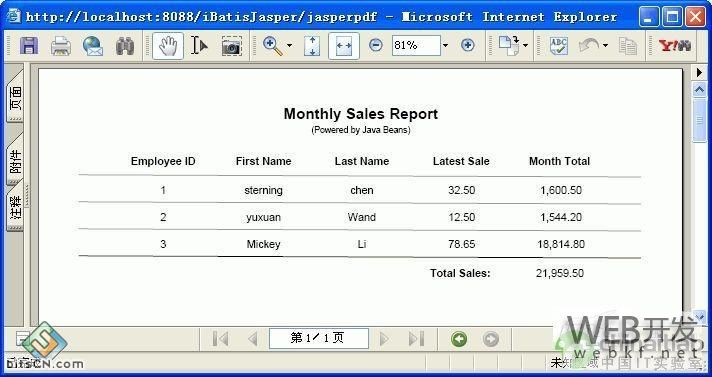
六、 小结
在本文中,笔者展示了如何使用比较成熟的iBATIS数据框架来对JasperReport进行数据填充。iBATIS最大的特点是简单,而iBATIS所拥有的易维护及易配置特性,在JasperReport中充分的体现出来了。这种简单与灵活性,正好弥补了JasperReport在这方面的不足,从而达到灵活开发Web报表的目的。
以上是 使用JasperReport与iBATIS开发Web报表 的全部内容, 来源链接: utcz.com/p/205646.html

